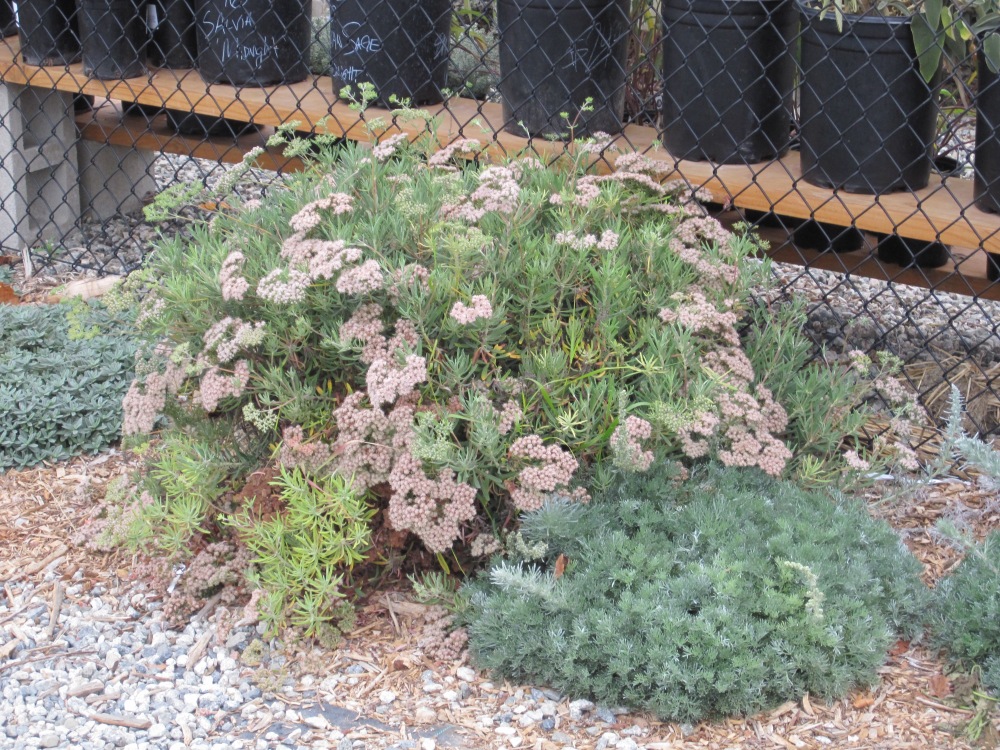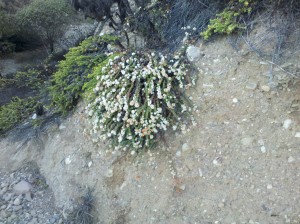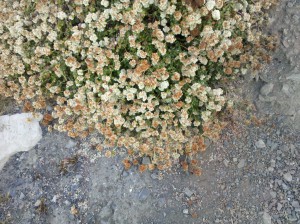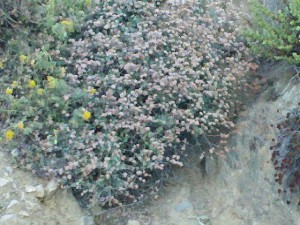What’s up world, thanks for checking in on my little blog, hopefully it will get huge one day and I can sell it and not have to do this anymore, but until then let’s all pretend to enjoy the ride………
Native Buckwheats (yeah, awkward transition!), California Native to be exact, not to be used in your pancakes or racist jokes, but in your garden. When I talk to people about California native plants, if they don’t fall asleep, I try to mention that SOMETHING is almost always looking good in our local mountains. Yup, even now at the end of Summer, where we haven’t seen any real rain since May (or April?) and probably won’t until at least October or November, something is still looking good in them there hills! On a recent drive along our beautiful Ventura County coastline (805!), I came across, within a few miles of each other, these pearls of delight. (CLICK ON PHOTOS TO MAKE THEM LARGER)
Now, I gotta make a disclaimer here, I am not a Botanist or Plant Scientist, I dropped out of most of my Agriculture and Botany Classes (like a good Chicano) and I am pretty much a rookie when it comes to identifying plants in the wild that are not commonly used in gardens….That being said, I am kinda sure the plant above is Eriogonum parvifolium v. paynei, or San Buena Ventura Buckwheat. At the very least I am sure it is some form of Eriogonum parvifolium, or Coastal Buckwheat, which in itself is a pretty cool find right across the street from the beach. Anyways, this plant is pretty much defying gravity out here on the coast between Oxnard and Malibu, just hanging out on a prime piece of real-estate that most Hollywood Stars would love to get their hands on, build a house and then cry when it washes or burns away (Oprah!). I love those flowers, they look a little bit like popcorn, the older ones look like burnt popcorn, and these plants have been flowering for months.
To the left and right is Eriogonum cinereum, or Ashyleaf Buckwheat, one of my favorite, and in my humble opinion, most underused native plants in local gardens. Let’s do the math real quick on this one…..This plant is currently living in rocky, dry soil, has had no rain for 4 months, maybe more, is getting blasted by afternoon sun and it still looks good enough to use in your garden? Yup! Did we just become best friends? Yup! Anybody want to go do karate in the garage? Yup!……Whatever you do, don’t go looking for this plant cuz’ I already removed it so it can live happily ever after in my garden……..just kidding…….it probably won’t survive being transplanted from the wild and die within a few weeks, but those are gonna be a few beautiful weeks! Seriously, now is the time to have that conservation conversation……Please don’t remove native plants from the wild, some of them really are rare and they already have enough to deal with without you and your 10 friends stepping all over them and their little babies. Alright, back to the Buckwheats…….One final photo

Santa Cruz Island Buckwheat next to Artemisia 'David's Choice', both plants less than 10 months old.
Above is probably my favorite California native buckwheat, the rare Santa Cruz Island Buckwheat (Eriogonum arborescens). Planted in January at Nopalito Native Plant Nursery in Ventura, this specific plant began flowering in July and shows no signs of stopping. I love the combination of whitish pink flower heads next to older brown flowers, along with unique leaves and the AWESOME bark, which you can’t see in this picture but is curvy, reddish brown and slightly shredding, a little like the famous manzanita plant.
SO,What’s the point of all of this? Well, besides getting you to buy more overpriced plants at our native plant nursery in Ventura, my main point is this……..Buckwheats are the bomb! Their flowers, from white, pink, red and yellow to all different shades of coppery cinammon brown, are a common site along our local hillsides and roads, so it’s a good bet many of them will work in your Southern California low-water garden. Many of the buckwheats flower their little buds off during the summer, while you can count on some to show off in the Spring, and many can keep the colors coming in the fall, all with LITTLE OR NO WATER! Just think, if the only thing keeping these plants looking good are Bambi’s dead-beat dad and the rythyms of our local seasons, how beautiful might these plants look in your garden with a little bit of love? If you are thinking about planting a California native plant garden, or even just a water-wise garden, think about using some buckwheats. They attract butterflies and bees like mad, they are usually completely drought-tolerant, and they come in different sizes, like smallish, biggerish, and wow i didn’t know it would be a small tree. Most of the buckwheats are grown by seed, and since they are used so little in gardens they can be almost impossible to find in local nurseries. But never fear, Nopalito is here! We currently have 6 varieties of buckwheats in stock, and with the big Fall planting season coming up we should have a great selection throughout the next few months. And, if you would like some ideas as to what to combine with buckwheats in the garden and how to prune them, sign up for our hands-on workshop with award-winning author Carol Bornstein on November 6th! Or, if you are looking for a beginners guide to California native plants, consider attending Lili Singer’s ‘The ABC’s of California Native Plant Gardening’ class, being held that same afternoon. You can find a complete calendar of our lectures at our website http://www.nopalitonursery.com, and as always…….Plant Native, Enjoy Life!!




Love the blog! One of my favs is eriogonum grande rubescens. Beautiful rose color flowers are an attention getter in any garden.
Hi Lisa, I love grande rubescens too, it does grab your attention like you said, and it has that neat element of being a local island plant as well. I hope to blog soon about Eriogonum latifolium, that is pretty closely related to red buckwheat, just more consistently smaller and it somes in a beautiful gray leaf version. I have a few in my garden in Oxnard and they went for over a year without supplemental water and were some of the best looking plants in the garden. See you at the workshopom Saturday!
Love the info and the attitude. Who knew Native Plants could find a home in cyberspace.
Hi Rick, thanks for your comment on my new blog, I always knew there was a spot for native plants in cyber space, especially considering what else cyberspace is home to! Wow, there is some pretty creepy stuff out there, hope this little blog can keep a few people informed and interested in our local plants!
What a great idea. I love your witticisms and also the information you give on buckwheats. Keep up the good work!
Thanks for the comment Fran, I hope I can keep this interesting and informative for years and years (or weeks and weeks) to come!
Great blog. You’re right, buckwheats are underused. My
My parents have the standard bearer, fasciculatum in their
backyard and it has all white heads and looks great.
Hi Paul, thanks for replying to my blog, yeah, I would have to say fasciculatum is the standard bearer, it is one of those plants that is hard to put an exact description on because I have seen some tiny ones, then there are the beasts that can reach 8 feet wide, then there are the abusive ones that find a fence or wall and start climbing all over it and suddenly you have a buckwheat vine/ small oak tree. Take care!
>Yeah! Love the blog. Love this plant.< Buckwheats have impressed me for the same reasons you mention– no water. They are a highly useful element of chapparal, which needs replanting in many areas of SoCal. Thanks for telling everyone not to pick or transplant them. BUT–
How about some tips on propagation? (Yes, I'll still buy Napolito! But I need ten dozen of these on my neighbor's gritty hillside– he's sanding the paint off my car!)
Also, it is Edible Landscaping:
http://www.versagrain.com/buckwheat-recipe.html
cheers!
Hi David, thanks for your reply, no doubt the buckwheat are a staple of our chaparral, the other 2 being McDonalds restaurants and the non-native Castor Bean, it’s late, what can I say? As for propagation, you just gave me another profitable idea, maybe we should have a propagation class?!? Most of our local buckwheats are EMBARRASSINGLY easy from seed, as well as from cuttings. As i mentioned in the blog they don’t transplant well from the wild (HAH!), but you may be on to something with this propagation idea. I helped teacha few prop. classes at Theodore Payne in Sun Valley and was always amazed at the enthusiasm some regular old folks have for wanting to grow local stuff. Pretty Cool, also, just to let you know, our buckwheats, as far as i know, are not or were not used as food, that buckwheat is the cultivated Fagopyrum esculentum. I think I’ll make my next entry about some native edibles. See ya!
Thanks for providing a voice to the Buckwheat of California! And with an attitude that makes it even more fun to read.
I have had buckwheat in my garden for years. I first purchased it at the Theodore Payne Nursery. No surprise, they were the ones to get me hooked on it.
I’ve got Eriogonum giganteum, ‘St. Catherine’s Lace,’ and Eriogonum grande rubescens, ‘Red Buckwheat,’ growing. I’ve had both of these pumping out flowers for 7 years now. They are mostly neglected and watered in the summer only a handful of times. People love them when they see them and I feel almost guilty (not really) taking any credit.
When they flower, the show lasts, literally, forever. I keep the dried blooms intact through winter as they turn rusty bronze. They add lots of interest to the colder months. Which in most of SoCal is like what . . . a frostbitten low of 45º?!
Keep up the good work on the blog. I’ll keep visiting Nopalito and help you reach that first million bucks!
Cheers!
Hi John, thanks for your response to the blog, I used to work at Theodore Payne and a friend and volunteer there helped open my eyes to good ol’ buckwheats, and I’ve been fascinated ever since. I think it’s pretty sweet that you maiNtain your Eriogonums minimally and they shine like superstars, sometimes it’s hard to get people to understand that YES, many of our plants thrive on what we would call neglect. ‘THIS IS THE OXNARD P.D., PUT DOWN THE HOSE AND STEP AWAY FROM THE PLANT!’….. Hope to see you soon!
Welcome to the world of blogging – and what a great start! Beware this can suck time like nothing else you know of. About buckwheats — yes they are great! I am trying to plant more local natives down here in Pasadena and the common, ordinary coast buckwheat (Eriogonum fasciculatum) is great. Still blooming, as it has been all summer, with no irrigation at all.
Thanks for the comment Barbara, Yeah, I have heard from other folks that it may take a lot of time, fortunately we have a lot of free time right now because we are only trying to run a 7 day a week nursery, so I am hoping to be able to fit it in between 3:35 a.m. and 4:12 a.m., should be able to! There are just too many amazing things going on in and around the nursery and with our plants to not share it with the world, so we shall see how long it lasts. Much native love, Antonio
Welcome to the blogging world, keep up the good work!
So the new hot couple: buckerpod or bladderwheat?
The E. x Blissianum I got from you guys a few months ago is doing amazingly well here in Camarillo. Tiny white flowers everywhere and copious amounts of bees working it all day long. See y’all soon!
Yeah blissianum! I like the jokes, too. Bladderwheat for sure.
Love the blog and also what your nursery is doing for we Ventura County gardeners. The topics, speakers and your plant selection just keep getting better and better and I really enjoy your humor. Reading your newsletter is a delight! I will be back to replace what the gophers have decided to make their lunch from my front and back yard gardens. No more lawn at this home! Keep up the great job.
Thank you, if I had a webcam you could see me smiling, here’s what it looks like with computer keys =)